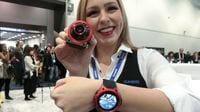Researchers are developing soft robotic tools for underwater research. The pressure-driven systems will allow marine biologists to examine delicate sea life without harming it.
More than 500 feet underwater in the Gulf of Eilat, researchers test new soft robotic grippers designed to collect samples of delicate sea life.
Replacing standard metallic grippers, these soft, squishy actuators could be a powerful new tool for biologists studying marine life. Mechanical engineer Kevin Galloway has this example.
Kevin Galloway, Mechanical Engineer, Harvard's Wyss Institute, saying:
"Give a coral reef a version of a colonoscopy. So what they can't do is go into some of these little burrows where these sea creatures live. They just don't have the instruments that are flexible enough, that are small enough to go in there."
But can something made from soft materials work under the pressure found at depth underwater?
Kevin Galloway, Mechanical Engineer, Harvard's Wyss Institute, saying:
"Yes, because all you need is a pressure differential. All of the soft robotics that we make are either hydraulic or air pressure driven. As long as the pressure inside is greater than the pressure outside you will get motion."
Kaitlyn Becker, Graduate student, saying:
"The memory foam does this really neat thing where as you start to squish it down, it hits a certain pressure. Now, if it were a spring as you squish a spring it gets higher and higher pressure as you squish it down, it is a linear relationship. But with the memory foam you press a little and you get some pressure, then as you keep squeezing it down it doesn't change."
That gives the researchers increased functionality when handling fragile sea life. The team plans to embed sensors on their soft grippers, helping them measure organisms and collect genetic data without removing them from their environment.
The engineers are also looking to add haptic feedback to their grippers. This will give researchers a sense of touch when exploring underwater.



